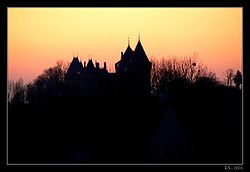
Château de Combourg
Encyclopedia

Castle
A castle is a type of fortified structure built in Europe and the Middle East during the Middle Ages by European nobility. Scholars debate the scope of the word castle, but usually consider it to be the private fortified residence of a lord or noble...
in the commune of Combourg
Combourg
Combourg is a commune in the Ille-et-Vilaine department in Brittany in north-western France.-Demographics:Inhabitants of Combourg are called Combourgeois and, more rarely Combournais.-History:...
in the Ille-et-Vilaine
Ille-et-Vilaine
Ille-et-Vilaine is a department of France, located in the region of Brittany in the northwest of the country.- History :Ille-et-Vilaine is one of the original 83 departments created during the French Revolution on March 4, 1790...
département, in Brittany
Brittany
Brittany is a cultural and administrative region in the north-west of France. Previously a kingdom and then a duchy, Brittany was united to the Kingdom of France in 1532 as a province. Brittany has also been referred to as Less, Lesser or Little Britain...
, France
France
The French Republic , The French Republic , The French Republic , (commonly known as France , is a unitary semi-presidential republic in Western Europe with several overseas territories and islands located on other continents and in the Indian, Pacific, and Atlantic oceans. Metropolitan France...
.
The castle stands on a small hill next to Lac Tranquille (Lake Tranquil) in the town.
The original castle on the site was built around 1025 by Archbishop Guinguené, who gave it to his illegitimate brother Riwallon
Rivallon I of Dol
Rivallon of Dol-Combourg was born to Hamo I, Viscount of Alet and Roianteline. He would enter marriage with Evrard, Count of Bretueil and Viscount of Chartres's daughter, Aremburga de Puiset. He died around 1065. In his lifetime, he rebelled against Conan II, Duke of Brittany with the aid of...
. Major alterations were made between the 15th and 19th centuries.
The castle consists of four large, powerful buildings of dressed granite
Granite
Granite is a common and widely occurring type of intrusive, felsic, igneous rock. Granite usually has a medium- to coarse-grained texture. Occasionally some individual crystals are larger than the groundmass, in which case the texture is known as porphyritic. A granitic rock with a porphyritic...
, with crenellations and machicolations, enclosing a rectangular courtyard. In each corner of this massive fortress is a round tower, also with crenellations and machicolations, with conical roofs.
In 1761, the Chateaubriand family acquired the property and it was the childhood home of François-René de Chateaubriand
François-René de Chateaubriand
François-René, vicomte de Chateaubriand was a French writer, politician, diplomat and historian. He is considered the founder of Romanticism in French literature.-Early life and exile:...
(1768–1848).
Arthur Young, the English writer and economist, visited Combourg on his travels through France in 1788. He wrote of scathingly of the town and described the castle thus:
SEPTEMBER 1 [1788]..... [Y]et here is a chateau, and inhabited; who is this Monsieur de Chateaubriant, the owner, that has nerves strung for a residence amidst such filth and poverty?
Chateaubriand
François-René de Chateaubriand
François-René, vicomte de Chateaubriand was a French writer, politician, diplomat and historian. He is considered the founder of Romanticism in French literature.-Early life and exile:...
commented later: "This M. de Chateaubriand was my father. The retreat that seemed so hideous to the ill-tempered agronomist was a fine and noble dwelling, albeit dark and solemn." He did not comment on Young's description of the town.
Privately-owned, the Château de Combourg is listed as a monument historique
Monument historique
A monument historique is a National Heritage Site of France. It also refers to a state procedure in France by which national heritage protection is extended to a building or a specific part of a building, a collection of buildings, or gardens, bridges, and other structures, because of their...
by the French Ministry of Culture. This building is open to the public.

